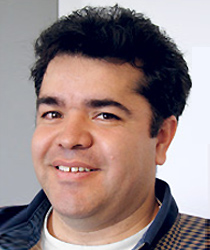
Aranda-Espinoza, Helim
Associate Professor
Fischell Department of Bioengineering
Materials Science and Engineering
Materials Science and Engineering
3108 A. James Clark Hall
EDUCATION
Ph.D., Universidad de San Luis Potosi, Mexico, 1998
Chemical and biological engineering, soft condensed matter, biomechanics and biopolymers.
The Cell Biophysics Laboratory is primarily concerned with the spreading, motility, and division of cells on flexible substrates.What is the effect of the mechanical environment on cells? Current and recent research thrusts include:
- Cell adhesion controls and mitosis
- Cell spreading: The role of Filopedia in symmetry breaking
- Cell–cell interaction; or, the importance of being a good neighbor
- Cholesterol effect on cell adhesion and mechanics
- Morphology of vesicles as a function of lipid content
- Cholesterol homeostasis: from vesicle to cellular funciton
- BIOE689M: Cell Motility. Fischell Department of Bioengineering. Fall 2007. University of Maryland.
- BIOE605: Laboratory Rotation I. Fischell Department of Bioengineering. Fall 2007.
- BIOE608: Bioengineering Seminar Series. Fischell Department of Bioengineering. Fall 2007.
- Course: Biophysics of Cell Motility. XX Meeting on the Science and Technology of Complex Fluids. Physics Institute, University of San Luis Potosi, Mexico. June 25-29, 2007.
- ENCH300: Chemical Process Thermodynamics. Department of Chemical and Biomolecular Engineering. Spring 2007. University of Maryland.
- BIOE689M: Cell Motility. Fischell Department of Bioengineering. Fall 2006. University of Maryland.
- ENCH620: Methods of Engineering Analysis. Department of Chemical and Biomolecular Engineering. Fall 2005. University of Maryland.
For a complete list of courses taught, please visit Professor Aranda-Espinoza's web site
CELLS
- Neutrophil Spreading: From Touchdown to First Steps.. With K. Sengupta, Lee Smith, P. Janmey, and D. Hammer. Biophys. J. (In Press). Spreading of neutrophils is explored using interference microscopy. Neutrophils show anisotropic spreading with adhesion dependent growth.
- Interplay Between Shear Stress and Adhesion Ligands on the Locomotion of Human Neutrophils. With Lee Smith, J. Haun, and D. Hammer. Biophys. J. (In Press). The effect of flow and adhesive substrates on neutrophil motility is explored in this paper.
- Cholesterol Depletion Increases Membrane Stiffness of Aortic Endothelial Cells. With F. Byfield, V. Romanenko, G. Rothblat, and I. Levitan. Biophys. J. 87 (2004) 3344. Is cholesterol good for you?
VESICLES
- Shapes of Mixed Phospholipid Vesicles. With G. Paredes and A. Maldonado Arce. J. Biol. Phys. Description of the morphology of vesicles as a function of the membrane lipid mixture. Cylindrical vesicles form coils when an external perturbation is imposed.
- Pore Stability and Dynamics in Polymer Membranes. With H. Bermudez, D. A. Hammer, and D. E. Discher. Europhys. Lett. 64 (2003) 550. Membrane thickness allows to control the dynamics of pores, from slow growing kinetically trapped holes.
- Electromechanical Limits of Polymersomes. With H. Bermudez, F. S. Bates, and D. E. Discher, Phys. Rev. Lett. 87 (2001) 208301. A study on the stability of vesicles as a function of membrane thickness. Thicker is tougher but thinner is more functional.
BIOPOLYMERS
- Flexibility Transitions and Looped Adsorption of Worm-like Chains. With P. Dalhaimer, O. I. Wagner, J.-F. Leterrier, P. A. Janmey, and D. E. Discher. J. of Polymer Sci. B 43 (2005) 280. Polymer adsorption to 2D substrates modifies the persistence length.
- Elongation and Fluctuations of Semi-flexible Polymers in a Nematic Solvent. With Z. Dogic, J. Zhang, A.W.C. Lau, P. Dalhaimer, D. Discher, P. A. Janmey, R.D. Kamien, T.C. Lubensky, and A. Yodh. Phys. Rev. Lett. 92 (2004) 125503. Aligning the tracks!
- Domain Unfolding in Neurofilament Sidearms: Effects of Phosphorylation and ATP. With P. Carl, P. Janmey, J. F. Leterrier, and D. E. Discher, FEBS Letters 531 (2002) 397. An electrostatic bridge is responsible for the large force required to fold a charged polymer.
THEORY
- Electrostatically Induced Undulations of Lamellar DNA-Lipid Complexes. With H. Schiessel. European Phys. J. E 5 (2001) 499.
- Interaction Between Inclusions Embedded in Membranes. With A. Berman, N. Dan, P. Pincus, and S. Safran, Biophys. J. 71 (1996) 648.
- Static Structure of the Two-Dimensional Hard-Disk Plus Yukawa Fluid. With M. Medina Noyola and J.L. Arauz Lara, J. Chem. Phys. 99 (1993) 5462.
OTHER
- Cholesterol Depletion Constrains Mechanical Deformation of Aortic Endothelial Cells. With F. Byfield, V. Romanenko, G. Rothblat, and I. Levitan. Proceedings of the IASTED International Conference on Biomechanics. (2003) 86.
- Hydrodynamics of Polymer Membranes. With P. Dalhaimer, F. S. Bates, and D. E. Discher. Comptes Rendus de l’Academie des Sciences – Series IV Physics-Astrophysics 4 (2003) 251.
- Electrostatic Repulsion of Positively Charged Vesicles and Negatively Charged Objects. With Yi Chen, N. Dan, T. C. Lubensky, P. Nelson, L. Ramos, and D.A. Weitz, Science 285 (1999) 394.
- Structure Factor of Flexible Membranes. With D. Lavallee, Europhys. Lett. 43 (1998) 355.
- Virus Cell-Fusion. With S. Aranda. II Mexican Symposium on Medical Physics. American Institute of Physics Conference Proceedings 440, 211 (1998).
- Structure and Self-diffusion in a Model Two-dimensional Brownian Liquid. With M. Carbajal-Tinoco, E. Urrutia-Banuelos, J.L.Arauz-Lara, M. Medina-Noyola, and J. Alejandre, J. of Chem. Phys. 101 (1994) 10925.